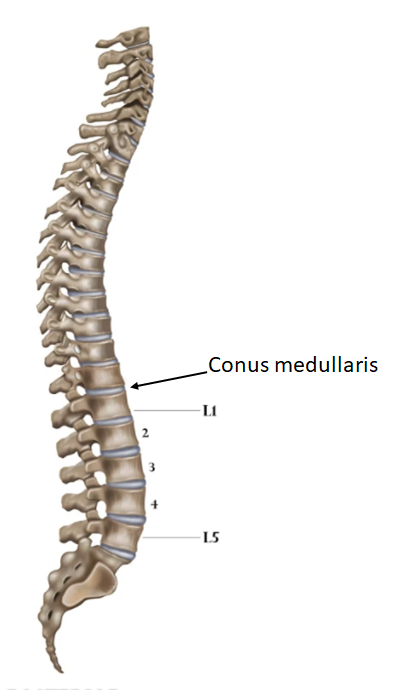
The last end of the spinal cord is called
(a) Cauda equina
(b) Conus medullaris
(c) Funiculus
(d) Fasciculi
Answer
577.8k+ views
Hint: This is the most distal bulbous part of the spinal cord which has tapering end as the filum terminale. Based on the presence of the spinal cord in vertebrates, it is divided into different parts.
Complete answer:
The spinal cord ends in a region known as the conus medullaris.The conus medullaris or conus terminalis is the narrowing, lower end of the spinal cord. It is present near lumbar vertebral levels 1 and 2 and occasionally lower.
Cauda equina: The cauda equina is a group of spinal nerves consisting of the second to the fifth lumbar nerve pairs, the first to the fifth sacral nerve pairs, and the coccygeal nerve, all of which arise from the lumbar enlargement and the conus medullaris of the spinal cord.
Funiculus: A funiculus is a small bundle of axons surrounded by the perineurium. A small nerve may comprise a single funiculus, but a larger nerve will contain several funiculi collected together into larger bundles termed as fascicles.
Fasciculi: The fasciculi are the bundles of structures, such as nerve or muscle fibers, or conducting vessels in plants. Example several funiculi collected together form fascicles.

So, the correct answer is “conus medullaris.”
Note: The pia mater that surrounds the spinal cord projects directly downward, forming a fine filament called the filum terminale, which attaches to the conus medullaris to the back of the coccyx. The filum terminale forms a connection between the conus medullaris and the coccyx which stabilizes the entire spinal cord.
Complete answer:
The spinal cord ends in a region known as the conus medullaris.The conus medullaris or conus terminalis is the narrowing, lower end of the spinal cord. It is present near lumbar vertebral levels 1 and 2 and occasionally lower.
Cauda equina: The cauda equina is a group of spinal nerves consisting of the second to the fifth lumbar nerve pairs, the first to the fifth sacral nerve pairs, and the coccygeal nerve, all of which arise from the lumbar enlargement and the conus medullaris of the spinal cord.
Funiculus: A funiculus is a small bundle of axons surrounded by the perineurium. A small nerve may comprise a single funiculus, but a larger nerve will contain several funiculi collected together into larger bundles termed as fascicles.
Fasciculi: The fasciculi are the bundles of structures, such as nerve or muscle fibers, or conducting vessels in plants. Example several funiculi collected together form fascicles.

So, the correct answer is “conus medullaris.”
Note: The pia mater that surrounds the spinal cord projects directly downward, forming a fine filament called the filum terminale, which attaches to the conus medullaris to the back of the coccyx. The filum terminale forms a connection between the conus medullaris and the coccyx which stabilizes the entire spinal cord.
Recently Updated Pages
Why are manures considered better than fertilizers class 11 biology CBSE

Find the coordinates of the midpoint of the line segment class 11 maths CBSE

Distinguish between static friction limiting friction class 11 physics CBSE

The Chairman of the constituent Assembly was A Jawaharlal class 11 social science CBSE

The first National Commission on Labour NCL submitted class 11 social science CBSE

Number of all subshell of n + l 7 is A 4 B 5 C 6 D class 11 chemistry CBSE

Trending doubts
10 examples of friction in our daily life

One Metric ton is equal to kg A 10000 B 1000 C 100 class 11 physics CBSE

Difference Between Prokaryotic Cells and Eukaryotic Cells

1 Quintal is equal to a 110 kg b 10 kg c 100kg d 1000 class 11 physics CBSE

State the laws of reflection of light

Explain zero factorial class 11 maths CBSE




